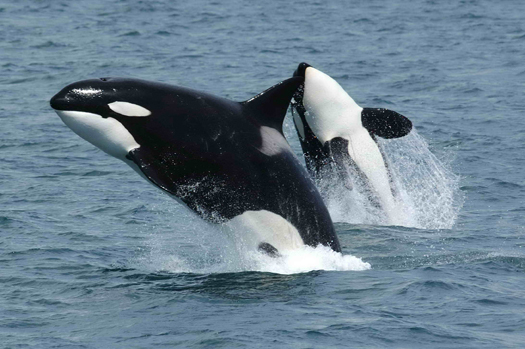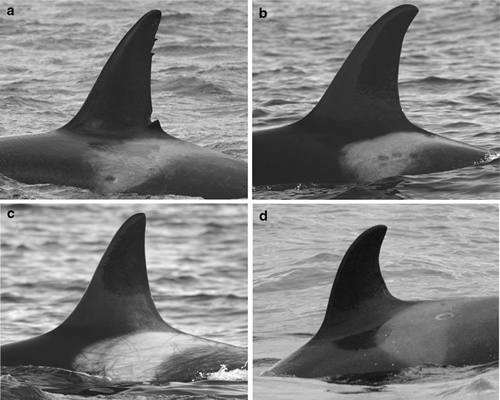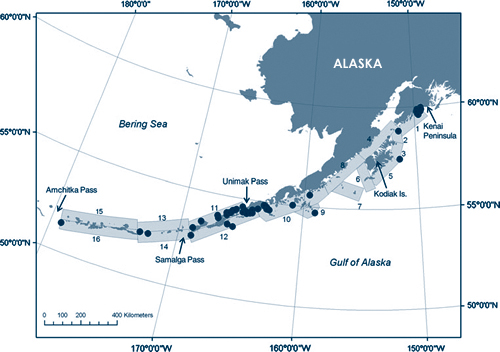
NE Pacific Transient killer whales in the Aleutian Islands, Alaska. Photograph taken during research conducted under permit 782-1719 issued by National Marine Fisheries Service (U.S.) under the authority of the Marine Mammal Protection Act. Photo: Dave Ellifrit, NOAA Alaska Fisheries Science Center
The sleek dorsal fin of a killer whale is an unmistakable sight in any ocean, but to the practiced eye of a marine biologist, a fin is as good as a fingerprint. Clues from the fin’s shape, the unique pattern of naturally acquired scarring and the pigmentation of the adjacent “saddle patch” help biologists to identify individual whales and their family group.
Subtle differences in morphology and pigmentation can signal a fish-eating resident whale or a marine mammal-eating transient. While the predictable seasonal appearance of the residents has provided scientists with ample opportunity for study, relatively little is known about the transients, which appear and disappear with confounding abruptness.
In central Alaska, transient killer whales pose difficult questions to biologists studying endangered Steller sea lions. Are hungry transients contributing to a local decline of Steller sea lions? How many transients are active in the area, and how much do they eat? Could killer whale predation push Steller sea lion populations over the brink?
Photographic Evidence
To answer these and other questions, a team of scientists analyzed thousands of photographs of dorsal fins to estimate the number of transients in coastal waters around breeding rookeries of endangered Steller sea lions from the central Gulf of Alaska to the central Aleutian Islands. Funding from the Consortium and other research partners supported a combination of field research and statistical analysis to estimate the total population of transients in the area, the results of which were recently published in the journal Marine Biology.
“With a study area of nearly 220,000 km2, it would have been impossible to survey the entire area uniformly from a ship,” says Dr. John Durban, a population ecologist at the NOAA Alaska Fisheries Science Centre and the study’s lead author. “Transients also move in and out of this area, occur in social groups and gathering near food sources, so we couldn’t design a classic mark-recapture survey with an equal probability of sighting and re-sighting in all areas. Instead, we gathered all available photo-identification data to estimate sighting probabilities and therefore the number of undetected whales.”

Photographs showing examples of natural markings used to identify individual killer whales.
Durban and colleagues identified 154 individual transients from 6,489 photographs collected between July 2001 and August 2003. Most of the photographs they examined were of fish-eating residents and were excluded from the study. Based on the remaining photographs, the team conducted a complex statistical analysis to estimate a total of 345 transients in the area.
Previous studies have suggested that fewer than 40 killer whales could have caused the recent Steller sea lion decline in the Aleutian Islands, if their predation was focused entirely on sea lions.
“Our abundance estimate shows that there are sufficient mammal-eating killer whales to cause substantial impacts through predation, depending on their dietary preferences and movement patterns,” Durban says.
The researchers provide one important qualifier: not all 345 transients were in the area at the same time. The abundance estimate, they note, refers to the number of killer whales that used the study area at some time during the study period, and does not imply that all remained within the area for the entire duration of the study. This creates both a temporal and a spatial variation in predatory pressure on coastal marine mammals. Specifically, the study also suggests that transient populations were gathering and moving away from the near-shore waters over the study period, Durban notes. “This will reduce the average risk of predation for coastal marine mammals,” he says.

Study area
“In the regional context of the Gulf of Alaska and Aleutian Islands, this study provided a relatively precise estimate of the number of mammal-eating killer whales using coastal waters,” says Durban. “Notably, these waters covered much of the range of the endangered western stock of Steller sea lions, and there is considerable interest in the role of killer whale predation in possibly reducing and now limiting the numbers of Steller sea lions and other marine mammals in this region.”
Durban anticipates that this approach will be useful to other land- or sea-based research studies where abundance estimation is required but survey design and capture probabilities cannot always be directly controlled. “This will particularly be the case for large study areas, but is also typical when using non-standard approaches such as photo identification or genetic identification.”
November 22, 2010
SEE PUBLICATION:
|

|

 |
||||||||||||
